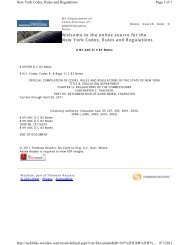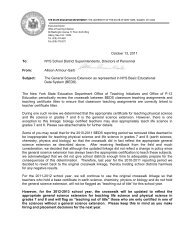ESL Learning Standards - Higher Ed - New York State Education ...
ESL Learning Standards - Higher Ed - New York State Education ...
ESL Learning Standards - Higher Ed - New York State Education ...
You also want an ePaper? Increase the reach of your titles
YUMPU automatically turns print PDFs into web optimized ePapers that Google loves.
Students will demonstrate cross-cultural knowledge and sensitivity in communicating with others of<br />
varied social, cultural, and linguistic backgrounds. They will develop and use culturally appropriate<br />
behaviors, and a knowledge of local and U.S. cultures and practices, in their interactions with<br />
others in their new cultural environment.<br />
Performance Indicators: See page 28<br />
Advanced<br />
Students complete Intermediate task and videotape each<br />
skit. Class discusses each skit in terms of misunderstandings,<br />
miscues, and misinformation that made the experience<br />
noteworthy (e.g., what made it funny, frightening, confusing,<br />
etc.). Misinformation is categorized by situation (e.g.,<br />
involving schools, doctors, directions, transportation, etc.).<br />
Teacher provides students with strategies and phrases in<br />
American English to avoid these problems or repair miscommunication.<br />
Performance indicators: 1, 3, 4<br />
English Proficiency Level<br />
Transitional<br />
Students complete Advanced task. They develop a “culture<br />
quiz” based on their own experiences as depicted in the<br />
skits. The quiz provides the situation and three optional<br />
responses, one of which is most appropriate for American<br />
English-speaking culture. Quiz is shared with other <strong>ESL</strong><br />
classes.<br />
Performance indicators: 1, 3, 4<br />
Students phone reference librarians for titles of stories that<br />
celebrate food around the world. Students locate stories<br />
and read them (silently, with a partner, or in groups).<br />
Students discuss the celebratory nature of foods. Then they<br />
bring from home a recipe that is prepared for special occasions,<br />
and they write about a memorable time when the<br />
dish was prepared. Recipes and essays are included in a<br />
class recipe book.<br />
Performance indicators: 3, 6<br />
Students complete Intermediate task. They create a chart of<br />
common elements (e.g., magic, good, evil, happy ending).<br />
Then they read two more Cinderella stories and complete<br />
the chart for all four stories. Students reflect on the chart<br />
and each student writes a short essay comparing two of the<br />
stories. Students share essays in class.<br />
Performance indicators: 5, 6<br />
Students call local restaurants and make inquiries to find a<br />
restaurant that serves a dish from their country. Students<br />
ask to have menus mailed to them, and they publish a simple<br />
“where to go” guide for international cuisine. The class<br />
sends the guide to local organizations (e.g., Chamber of<br />
Commerce, Welcome Wagon, city Public Relations<br />
Department) with a brief description of how the project<br />
evolved.<br />
Performance indicators: 1, 3<br />
Students complete Advanced task. Class creates a rubric for<br />
writing and assessing an original Cinderella story (e.g., cultural<br />
indicators, common elements, writing process).<br />
Students write a Cinderella story based on their own culture.<br />
They use the writing process (e.g., peer conferencing,<br />
revising, editing) to publish stories for class book.<br />
Performance indicators: 5, 6<br />
<strong>ESL</strong><br />
5<br />
Interm<br />
Students complete Intermediate task, comparing all four<br />
topics. Each student produces a brief informative pamphlet<br />
for native English-speaking peers that compares the two<br />
cultures and highlights what an American can expect in the<br />
student’s native country.<br />
Performance indicators: 1, 2, 3, 5<br />
Students present their brochure to native English-speaking<br />
students in a non-<strong>ESL</strong> class. Students confirm their description<br />
of American culture and add variations provided by<br />
the non-<strong>ESL</strong> students. Topics comparing U.S. cultures with<br />
other cultures are chosen by class for inclusion in intercultural<br />
newsletter. Class negotiates research responsibilities.<br />
Each student writes an article and assumes a production<br />
role (e.g., editing, layout). Students publish newsletter.<br />
Performance indicators: 1, 2, 3, 5<br />
Continued on next page<br />
CLASSROOM<br />
TASKS<br />
Sample Classroom Tasks 85
















